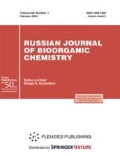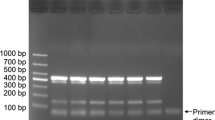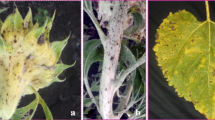Abstract
A PCR system in the fluorescent amplification-based specific hybridization (FLASH) format was developed for the detection and identification of two important wheat pathogenic fungi Septoria tritici (teleomorph of Mycosphaerella graminicola) and Stagonospora nodorum (teleomorph of Phaeosphaeria nodorum), which cause spots on leaves and glumes, respectively. The pathogen detection system is based on the amplification of a genome fragment in the internal transcribed spacer 1 (ITS1) region and a site encoding the 5.8S ribosomal RNA. The forward primers to ITS1 and a universal reverse primer and a beacon type probe to the 5.8S ribosomal RNA region were chosen to provide the detection of the products in the FLASH format. This system was tested on different isolates of the pathogens, and on infected soil, leaf, and seed samples.
Similar content being viewed by others
Abbreviations
- FLASH:
-
fluorescent amplification-based specific hybridization
- PCR:
-
polymerase chain reaction
- IC:
-
internal control
- ITC:
-
internal transcribed spacer
References
King, J.E., Cook, R.J., and Melvill, S.C., Ann. Appl. Biol., 1983, vol. 103, pp. 345–373.
Eyal, Z., Scharen, A.L., Prescott, J.M., and Ginkel, M., The Septoria Diseases of Wheat: Concepts and Methods of Disease Management, Mexico, D. F.: CIMMYT, 1987, pp. 15–32.
Goodwin, S.B. and Zismann, V.L., Mycologia, 2001, vol. 93, pp. 934–946.
Goncharenko, N.F., Gorbacheva, N.P., and Sanin, S.S., Ekologo-ekonomicheskie osnovy usovershenstvovaniya integrirovannykh sistem zashchity rastenii ot vreditelei, boleznei i sornyakov (Ecological and Economical Basics of Improvement of Integrated Systems of Plant Protection from Pests, Diseases, and Weeds), Minsk, 1996, part 2, pp. 70–73.
Eyal, Z.E., Plant. Dis., 1981, vol. 65, pp. 763–768.
Andrianova, T.V., Abstracts of Papers, Int. Conf. Mikologiya i kriptogamnaya botanika v Rossii: traditsii i sovremennost’, (Mycology and Agamic Botany in Russia: Traditions and Current State), St. Petersburg, 2000, pp. 57–59.
Eyal, Z., Eur. J. Plant Pathol., 1999, vol. 105, pp. 629–641.
Sudnikova, V.P., Plakhotnik, V.V., and Artemova, S.V., Fitosanitarnoe ozdorovlenie ekosistem (Fitosanitary Recovery of Ecological Systems), St. Petersburg: Vseros. nauch.-issl. in-t zashchity rastenii, 2005, pp. 107–109.
Pyzhikova, G.V., Septoriozy zernovykh kul’tur. Obzornaya informatsiya (Septorioses of Cereal Cultures: Review Information), Moscow: VNIITEISKh, 1984.
Gilchrist, L. and Dubin, H.J., Septoria Diseases of Wheat, Rome: Bread wheat, Improvement and Production, 2002, pp. 273–277.
Ginkel, M., McNab, A., and Krupinsky, J., Septoria and Stagonospora Diseases of Cereals: A Compilation of Global Research. Mexico, D. F.: CIMMYT, 1999.
Joshi, M.M. and Sternberg, J.A., Proc. Brighton Crop Protection Conference, Pest and Diseases, Farnham, 1996, vol. 1, pp. 21–26.
Shcherbakova, L.A. and Umnov, A.M., Fitosanitarnoe ozdorovlenie ekosistem (Fitosanitary Recovery of Ecological Systems), St. Petersburg: Vseros. nauch.-issl. int zashchity rastenii, 2005, pp. 233–236.
Lagerberg, C., Gripwall, E., and Wiik, L., Seed Sci. & Technol., 1995, vol. 23, pp. 609–615.
Joerger, M.C., Hirata, L.T., Baxter, M.A., Genet, J.L., and May, L., Proc. Brighton Crop Protection Conf. Pests and Diseases, Farnham, 1992, vol. 2, pp. 689–695.
Junker, K., Proc. of 9th Danish Plant Protection Conf. Pests and Diseases, 1992, p. 133–138.
Gubiš J., Hudcovicovǎ M., Šlikova S., Vančo B., Biologia (Bratislava), 2005, vol. 60, pp. 681–684.
Beck, J.J. and Ligon, J.M., Phytopathology, 1995, vol. 85, pp. 319–324.
Elov, A.A., Fedorov, N.A., Zhiburt, E.B., Kofiadi, I.A., and Trofimov, D.Yu., Zdravookhranenie Medtekhnika, 2005, no. 2, p. 10.
Laptinov, I.A., PTsR-diagnostika bez elektroforeza. Laboratornaya diagnostika Rossii. Ezhegodnyi sprav. Mir meditsiny (PCR Diagnostics without Electrophoresis: Laboratory Diagnostics of Russia, Yearly Data Book Medicinal World), Moscow: Izd-vo Chelovek, 2004/2005, pp. 162–163.
Cunfer, B.M. and Ueng, P.P., Ann. Rev. Phytopathol., Palo Alto, CA, 1999, vol. 37, pp. 267–284.
Bilai, V.I., Gvosdyak, R.I., Skripal’, I.G., Kraev, V.G., Ellanskya, M.A., Zirka, G.I., and Muras, V.A., Microorganizmy—vozbuditeli boleznei rastenii (Microorganisms as Causal Agents of Plant Diseases), Kiev: Naukova Dumka, 1988, pp. 214–217.
Author information
Authors and Affiliations
Corresponding author
Additional information
Original Russian Text © S.L. Abramova, D.Yu. Ryazantsev, T.M. Voinova, S.K. Zavriev, 2008, published in Bioorganicheskaya Khimiya, 2008, Vol. 34, No. 1, pp. 107–113.
Rights and permissions
About this article
Cite this article
Abramova, S.L., Ryazantsev, D.Y., Voinova, T.M. et al. Diagnostics of phytopathogen fungi Septoria tritici and Stagonospora nodorum by fluorescent amplification-based specific hybridization (FLASH) PCR. Russ J Bioorg Chem 34, 97–102 (2008). https://doi.org/10.1134/S1068162008010135
Received:
Accepted:
Published:
Issue Date:
DOI: https://doi.org/10.1134/S1068162008010135




